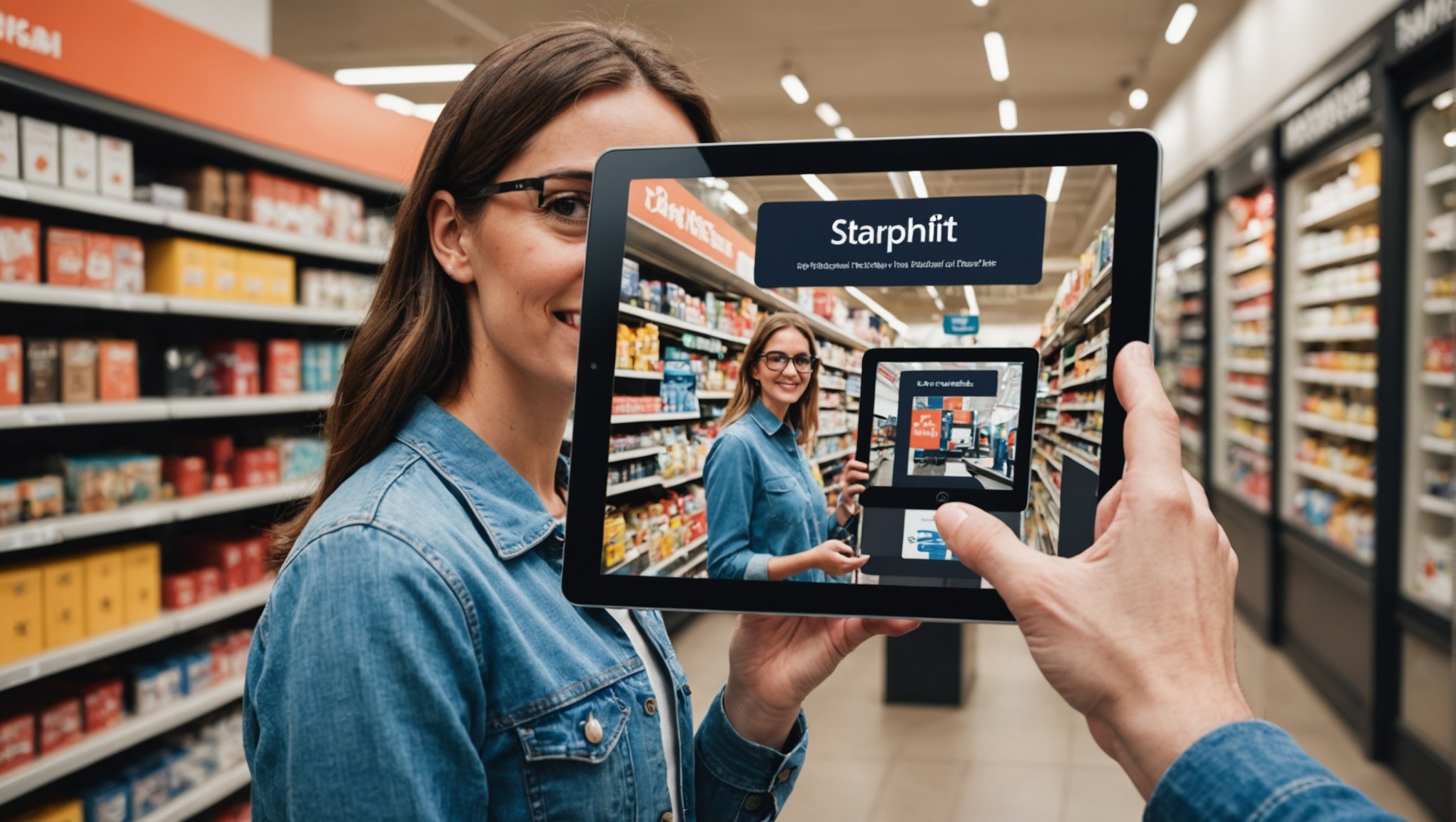Augmented Reality (AR) is revolutionising the retail landscape in the UK, offering innovative ways to engage customers and enhance in-store promotions. By integrating AR technologies, retailers can create immersive experiences that captivate shoppers, boost product visibility, and drive sales. This exploration reveals effective strategies tailored for UK retailers to leverage AR, transforming traditional promotions into interactive adventures. Discover how embracing this cutting-edge technology can position your brand ahead of the competition while enriching the customer experience.
Understanding Augmented Reality in Retail
Augmented Reality (AR) is a technology that overlays digital information onto the real world, enhancing the user's perception of their environment. Unlike virtual reality, which immerses users in a completely digital space, AR blends the physical and digital worlds. This retail innovation is transforming how consumers interact with products, offering a more immersive and engaging shopping experience.
Also to see : Boosting Member Experience: The Role of Wearable Technology in Revolutionizing UK Gyms
The importance of AR in retail lies in its ability to enhance customer experience. By allowing customers to visualize products in their own environment, AR technology reduces uncertainty and increases confidence in purchasing decisions. For instance, furniture retailers use AR to let customers see how a sofa would look in their living room before buying. This not only improves satisfaction but also reduces return rates.
Current trends in AR technology within the retail sector include the integration of AR in mobile apps and in-store experiences. Retailers are leveraging AR to provide virtual try-ons for clothing and makeup, interactive product demonstrations, and personalized shopping experiences. As AR technology continues to evolve, it is expected to become a standard tool in retail, driving further innovation and reshaping the future of shopping.
Topic to read : Unlocking Alumni Connections: Innovative Online Strategies for UK Universities
Successful Case Studies of AR in UK Retail
In recent years, several UK retailers have successfully integrated AR applications into their business strategies, showcasing the transformative power of this technology. Leading the charge is the furniture giant, IKEA, with its AR app that allows customers to virtually place furniture in their homes. This AR application has significantly enhanced customer satisfaction by reducing the guesswork involved in purchasing decisions.
Another notable case is fashion retailer ASOS, which implemented AR for virtual try-ons. This innovation not only improved the online shopping experience but also led to increased sales and reduced product returns. ASOS's campaign demonstrated how AR applications can bridge the gap between online and in-store shopping experiences, offering a seamless and engaging customer journey.
The beauty industry has also embraced AR, with brands like L'Oréal using it for virtual makeup try-ons. This retail success has empowered customers to experiment with products before buying, leading to higher conversion rates and customer loyalty.
From these case studies, it is evident that successful AR applications in retail hinge on enhancing customer experience and reducing purchase friction. Retailers can learn from these examples to strategically implement AR, ensuring it aligns with their brand and customer needs.
Strategies for Implementing AR in In-Store Promotions
Implementing AR integration in retail spaces requires a thoughtful approach to ensure success. The first step is to identify the specific retail promotions where AR can add value. This might include interactive displays, virtual try-ons, or gamified shopping experiences. Once identified, retailers should focus on developing engaging AR content that captivates customers and enhances their shopping journey.
Creating compelling AR content involves understanding the audience's preferences and crafting experiences that resonate with them. This could mean designing interactive product demonstrations or offering exclusive promotions that can only be accessed through AR. Aligning these experiences with the retailer's overall marketing goals ensures a cohesive strategy that supports brand objectives.
To successfully implement these implementation strategies, retailers should:
- Assess their technological capabilities and invest in the necessary infrastructure.
- Collaborate with AR developers to create customised solutions tailored to their brand.
- Train staff to assist and educate customers on using AR features, enhancing the overall experience.
By carefully planning and executing these steps, retailers can effectively integrate AR into their in-store promotions, creating a dynamic shopping environment that attracts and retains customers.
Enhancing Customer Engagement with AR
Augmented Reality (AR) is revolutionising how retailers enhance customer engagement. By integrating AR experiences, retailers can create interactive and immersive environments that captivate customers.
One effective technique is the use of gamification in AR to boost in-store experiences. Retailers can design AR treasure hunts or interactive games that encourage customers to explore different sections of the store. This not only makes shopping more enjoyable but also increases the time customers spend in-store, ultimately enhancing retail interaction.
Personalisation through AR technology is another powerful approach. By leveraging customer data, retailers can offer tailored AR experiences. For instance, an AR app might suggest products based on previous purchases or preferences, allowing customers to see how these items fit into their lifestyle. This level of personalisation fosters a deeper connection between the customer and the brand.
Moreover, AR can transform the way customers interact with products. Virtual try-ons and interactive product displays provide a hands-on experience without the need for physical contact. This not only boosts customer confidence in their purchasing decisions but also creates a memorable shopping journey that encourages repeat visits.
Overcoming Challenges in AR Adoption
Adopting Augmented Reality (AR) in retail comes with its own set of challenges. Understanding these AR barriers is crucial for a seamless integration. Retailers often face technical hurdles, such as ensuring compatibility with existing systems and maintaining a user-friendly interface. Financial constraints also pose significant challenges, as developing and implementing AR solutions can be costly.
To address these retail solutions, retailers should consider a phased approach. Start by identifying specific areas where AR can add value, such as enhancing customer engagement or reducing product returns. This targeted strategy helps allocate resources effectively and demonstrates tangible benefits early on. Collaborating with experienced AR developers can also mitigate technical issues, ensuring the technology aligns with business needs.
Staff training and customer education are pivotal in overcoming these challenges. Employees must be well-versed in AR technology to assist customers effectively. Providing comprehensive training sessions and ongoing support can empower staff to become AR advocates. Similarly, educating customers on using AR features can enhance their shopping experience, fostering a positive perception of the technology.
By addressing these challenges, retailers can unlock the full potential of AR, creating a competitive edge in the evolving retail landscape.
Tips for Maximizing the Impact of AR Promotions
To harness the full potential of Augmented Reality (AR) in retail, it is crucial to implement best practices that enhance promotion effectiveness. A successful AR promotion hinges on several key elements, starting with a clear understanding of the target audience. Tailoring AR experiences to resonate with customers' preferences ensures higher engagement and satisfaction.
AR tips for effective implementation include focusing on intuitive design and seamless integration within existing retail platforms. Ensuring that AR features are easy to access and use will encourage customers to interact more frequently. Additionally, offering exclusive content or promotions through AR can incentivize customers to engage with the technology.
To evaluate the performance of AR campaigns, retailers should track specific metrics such as user engagement rates, conversion rates, and customer feedback. These metrics provide insights into the promotion effectiveness and help identify areas for improvement.
Looking ahead, the evolution of AR in retail is expected to include more personalized and immersive experiences. Future trends may involve advanced data analytics to further tailor AR interactions, enhancing customer loyalty and driving sales. By staying informed of these trends, retailers can continue to innovate and maintain a competitive edge.
The Role of Visual Aids in AR Marketing
Visual aids are pivotal in crafting compelling AR experiences. High-quality AR graphics are essential to captivate and engage customers, serving as a bridge between the digital and physical realms. Effective visual aids can transform mundane marketing efforts into immersive experiences that resonate with consumers.
In AR promotions, the use of visual aids such as interactive 3D models and dynamic animations can significantly enhance user engagement. For instance, a fashion retailer might use AR graphics to allow customers to visualise how clothing fits in real-time, thus enhancing the decision-making process. Similarly, automotive companies can employ detailed 3D car models to allow potential buyers to explore features virtually.
Creating robust AR visual content requires the right marketing tools and resources. Software like Unity and Adobe Aero are popular choices among developers for crafting visually stunning AR experiences. These tools provide a suite of features that enable the creation of intricate graphics and animations, ensuring the visual aids are both engaging and informative.
Incorporating these elements into AR marketing strategies not only elevates the consumer experience but also strengthens brand perception, making visual aids indispensable in the evolving landscape of retail marketing.
Expert Insights on the Future of AR in Retail
In the rapidly evolving retail landscape, expert opinions suggest that Augmented Reality (AR) is poised to revolutionise consumer experiences. Industry leaders predict that AR will increasingly personalise shopping, allowing customers to tailor their experiences based on preferences and past behaviours. This shift is expected to significantly impact consumer behaviour, with shoppers becoming more engaged and confident in their purchasing decisions.
Future trends in AR technology indicate a move towards more seamless integration within retail environments. Experts foresee AR becoming a standard feature in both online and physical stores, enhancing everything from product exploration to checkout processes. This evolution is anticipated to blur the lines between digital and physical shopping, creating a unified retail experience.
Interviews with industry experts highlight the potential of AR to transform shopping habits. As AR technology becomes more sophisticated, consumers are likely to expect interactive and immersive experiences as a norm. This change could lead to increased brand loyalty and higher conversion rates, as shoppers are drawn to retailers offering cutting-edge AR solutions.
Retail forecasts suggest that businesses embracing AR will gain a competitive edge, capitalising on the technology's ability to attract and retain customers in an increasingly digital world.











